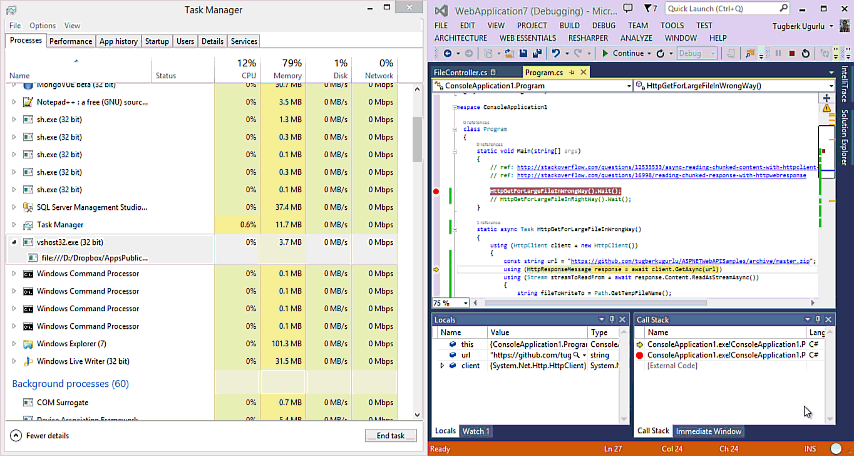Hierarchical Resource Structure in ASP.NET Web API
Related Posts
I came across a question on Stackoverflow today about the hierarchical resource structure in ASP.NET Web API: http://stackoverflow.com/questions/14674255. The question is basically about the following issue:
I have the following schema that I'd like to implement in ASP.NET Web API. What is the proper approach?
http://mydomain/api/students
http://mydomain/api/students/s123
http://mydomain/api/students/s123/classes
http://mydomain/api/students/s123/classes/c456
With this nice hierarchical approach, you have more concerns that routing here in terms of ASP.NET Web API. There is a good sample application which adopts the hierarchical resource structure: PingYourPackage. I definitely suggest you to check it out.
Let me explain the concerns here in details by setting up a sample scenario. This may not be the desired approach for these types of situations but lays out the concerns very well and if you have a better way to eliminate these concerns, I'd be more that happy to hear those.
Let's say you have the below two affiliates inside your database for a shipment company:
- Affiliate1 (Id: 100)
- Affiliate2 (Id: 101)
And then assume that these affiliates have some shipments attached to them:
- Affiliate1 (Key: 100)
- Shipment1 (Key: 100)
- Shipment2 (Key: 102)
- Shipment4 (Key: 104)
- Affiliate2 (Key: 101)
- Shipment3 (Key: 103)
- Shipment5 (Key: 105)
Finally, we want to have the following resource structure:
- GET api/affiliates/{key}/shipments
- GET api/affiliates/{key}/shipments/{shipmentKey}
- POST api/affiliates/{key}/shipments
- PUT api/affiliates/{key}/shipments/{shipmentKey}
- DELETE api/affiliates/{key}/shipments/{shipmentKey}
In view of ASP.NET Web API, we have three obvious concerns here: routing, authorization and ownership. Let's go through this one by one.
The below code snippets have been taken from the PingYourPackage source code. They won't probably work if you copy and paste them but you will get the idea.
Routing Concerns
Assume that we are sending a GET request against /api/affiliates/105/shipments/102 (considering our above scenario). Notice that the affiliate key is 105 here which doesn't exist. So, we would want to terminate the request here ASAP. We can achieve this with a per-route message handler as early as possible. The following AffiliateShipmentsDispatcher is responsible for checking the affiliate existence and acting on the result.
public class AffiliateShipmentsDispatcher : DelegatingHandler { protected override Task<HttpResponseMessage> SendAsync( HttpRequestMessage request, CancellationToken cancellationToken) { // We know at this point that the {key} route variable has // been supplied. Otherwise, we wouldn't be here. So, just get it. IHttpRouteData routeData = request.GetRouteData(); Guid affiliateKey = Guid.ParseExact(routeData.Values["key"].ToString(), "D"); IShipmentService shipmentService = request.GetShipmentService(); if (shipmentService.GetAffiliate(affiliateKey) == null) { return Task.FromResult( request.CreateResponse(HttpStatusCode.NotFound)); } return base.SendAsync(request, cancellationToken); } }
I am here using a few internal extension methods which are used inside the project but the idea is simple: go to the database and check the existence of the affiliate. If it doesn't exist, terminate the request and return back the "404 Not Found" response. If it exists, continue executing by calling the base.SendAsync method which will invoke the next message handler inside the chain. Which message handler is the next here? Good question, you dear reader! It's going to be the HttpControllerDispatcher which basically puts us inside the controller pipeline. To attach this handler to a route, we need to create a pipeline first to include the controller pipeline by chaining AffiliateShipmentsDispatcher and HttpControllerDispatcher together. The following code snippet shows the AffiliateShipmentsHttpRoute registration.
public class RouteConfig { public static void RegisterRoutes(HttpConfiguration config) { var routes = config.Routes; // Pipelines HttpMessageHandler affiliateShipmentsPipeline = HttpClientFactory.CreatePipeline( new HttpControllerDispatcher(config), new[] { new AffiliateShipmentsDispatcher() }); // Routes routes.MapHttpRoute( "AffiliateShipmentsHttpRoute", "api/affiliates/{key}/shipments/{shipmentKey}", defaults: new { controller = "AffiliateShipments", shipmentKey = RouteParameter.Optional }, constraints: null, handler: affiliateShipmentsPipeline); routes.MapHttpRoute( "DefaultHttpRoute", "api/{controller}/{key}", defaults: new { key = RouteParameter.Optional }, constraints: null); } }
Authorization Concerns
If you have some type of authentication in place, you would want to make sure (in our scenario here) that the authenticated user and the requested affiliate resource is related. For example, assume that Affiliate1 is authenticated under the Affiliate role and you have the AuthorizeAttribute registered to check the "Affiliate" role authorization. In this case, you will fail miserably because this means that Affiliate1 can get to the following resource: /api/affiliates/101/shipments which belongs to Affiliate2. We can eliminate this problem with a custom AuthorizeAttribute which is similar to below one:
[AttributeUsage(AttributeTargets.Class, AllowMultiple = false)] public class AffiliateShipmentsAuthorizeAttribute : AuthorizeAttribute { public AffiliateShipmentsAuthorizeAttribute() { base.Roles = "Affiliate"; } public override void OnAuthorization(HttpActionContext actionContext) { base.OnAuthorization(actionContext); // If not authorized at all, don't bother checking for the // user - affiliate relation if (actionContext.Response == null) { // We are here sure that the request has been authorized and // the user is in the Affiliate role. We also don't need // to check the existence of the affiliate as it has // been also already done by AffiliateShipmentsDispatcher. HttpRequestMessage request = actionContext.Request; Guid affiliateKey = GetAffiliateKey(request.GetRouteData()); IPrincipal principal = Thread.CurrentPrincipal; IShipmentService shipmentService = request.GetShipmentService(); bool isAffiliateRelatedToUser = shipmentService.IsAffiliateRelatedToUser( affiliateKey, principal.Identity.Name); if (!isAffiliateRelatedToUser) { // Set Unauthorized response as the user and // affiliate isn't related to each other. You might // want to return "404 NotFound" response here if you don't // want to expose the existence of the affiliate. actionContext.Response = request.CreateResponse(HttpStatusCode.Unauthorized); } } } private static Guid GetAffiliateKey(IHttpRouteData routeData) { var affiliateKey = routeData.Values["key"].ToString(); return Guid.ParseExact(affiliateKey, "D"); } }
This will be registered at the controller level for the AffiliateShipmentsController.
Ownership Concerns
Consider this URI for an HTTP GET request: /api/affiliates/100/shipments/102. This URI should get us the correct data. However, what would happen for the this URI: /api/affiliates/100/shipments/103? This should get you a "404 Not Found" HTTP response because the affiliate whose Id is 100 doesn't own the shipment whose id is 103. Inside the PingYourPackage project, I ensured the ownership of the resource with the following authorization filter which will be applied to proper action methods.
[AttributeUsage(AttributeTargets.Method, AllowMultiple = false)] public class EnsureShipmentOwnershipAttribute : Attribute, IAuthorizationFilter { private const string ShipmentDictionaryKey = "__AffiliateShipmentsController_Shipment"; public bool AllowMultiple { get { return false; } } public Task<HttpResponseMessage> ExecuteAuthorizationFilterAsync( HttpActionContext actionContext, CancellationToken cancellationToken, Func<Task<HttpResponseMessage>> continuation) { // We are here sure that the user is authanticated and request // can be kept executing because the AuthorizeAttribute has // been invoked before this filter's OnActionExecuting method. // Also, we are sure that the affiliate is associated with // the currently authanticated user as the previous action filter // has checked against this. IHttpRouteData routeData = actionContext.Request.GetRouteData(); Uri requestUri = actionContext.Request.RequestUri; Guid affiliateKey = GetAffiliateKey(routeData); Guid shipmentKey = GetShipmentKey(routeData, requestUri); // Check if the affiliate really owns the shipment // whose key came from the request. We don't need to check the // existence of the affiliate as this check has been already // performed by the AffiliateShipmentsDispatcher. IShipmentService shipmentService = actionContext.Request.GetShipmentService(); Shipment shipment = shipmentService.GetShipment(shipmentKey); // Check the shipment existance if (shipment == null) { return Task.FromResult( new HttpResponseMessage(HttpStatusCode.NotFound)); } // Check the shipment ownership if (shipment.AffiliateKey != affiliateKey) { // You might want to return "404 NotFound" response here // if you don't want to expose the existence of the shipment. return Task.FromResult( new HttpResponseMessage(HttpStatusCode.Unauthorized)); } // Stick the shipment inside the Properties dictionary so // that we won't need to have another trip to database. // The ShipmentParameterBinding will bind the Shipment param // if needed. actionContext.Request .Properties[ShipmentDictionaryKey] = shipment; // The request is legit, continue executing. return continuation(); } private static Guid GetAffiliateKey(IHttpRouteData routeData) { var affiliateKey = routeData.Values["key"].ToString(); return Guid.ParseExact(affiliateKey, "D"); } private static Guid GetShipmentKey( IHttpRouteData routeData, Uri requestUri) { // We are sure at this point that the shipmentKey value has been // supplied (either through route or quesry string) because it // wouldn't be possible for the request to arrive here if it wasn't. object shipmentKeyString; if (routeData.Values.TryGetValue("shipmentKey", out shipmentKeyString)) { return Guid.ParseExact(shipmentKeyString.ToString(), "D"); } // It's now sure that query string has the shipmentKey value var quesryString = requestUri.ParseQueryString(); return Guid.ParseExact(quesryString["shipmentKey"], "D"); } }
Now, this filter can be applied to proper action methods to allow the proper authorization. At the very end, the AffiliateShipmentsController class looks clean and readable:
[AffiliateShipmentsAuthorize] public class AffiliateShipmentsController : ApiController { // We are OK inside this controller in terms of // Affiliate existance and its relation with the current // authed user has been checked by the handler // and AffiliateShipmentsAuthorizeAttribute. // The action method which requests the shipment instance: // We can just get the shipment as the shipment // existance and its ownership by the affiliate has been // approved by the EnsureShipmentOwnershipAttribute. // The BindShipmentAttribute can bind the shipment from the // Properties dictionarty of the HttpRequestMessage instance // as it has been put there by the EnsureShipmentOwnershipAttribute. private const string RouteName = "AffiliateShipmentsHttpRoute"; private readonly IShipmentService _shipmentService; public AffiliateShipmentsController(IShipmentService shipmentService) { _shipmentService = shipmentService; } public PaginatedDto<ShipmentDto> GetShipments( Guid key, PaginatedRequestCommand cmd) { var shipments = _shipmentService .GetShipments(cmd.Page, cmd.Take, affiliateKey: key); return shipments.ToPaginatedDto( shipments.Select(sh => sh.ToShipmentDto())); } [EnsureShipmentOwnership] public ShipmentDto GetShipment( Guid key, Guid shipmentKey, [BindShipment]Shipment shipment) { return shipment.ToShipmentDto(); } [EmptyParameterFilter("requestModel")] public HttpResponseMessage PostShipment( Guid key, ShipmentByAffiliateRequestModel requestModel) { var createdShipmentResult = _shipmentService.AddShipment(requestModel.ToShipment(key)); if (!createdShipmentResult.IsSuccess) { return new HttpResponseMessage(HttpStatusCode.Conflict); } var response = Request.CreateResponse(HttpStatusCode.Created, createdShipmentResult.Entity.ToShipmentDto()); response.Headers.Location = new Uri( Url.Link(RouteName, new { key = createdShipmentResult.Entity.AffiliateKey, shipmentKey = createdShipmentResult.Entity.Key }) ); return response; } [EnsureShipmentOwnership] [EmptyParameterFilter("requestModel")] public ShipmentDto PutShipment( Guid key, Guid shipmentKey, ShipmentByAffiliateUpdateRequestModel requestModel, [BindShipment]Shipment shipment) { var updatedShipment = _shipmentService.UpdateShipment( requestModel.ToShipment(shipment)); return updatedShipment.ToShipmentDto(); } [EnsureShipmentOwnership] public HttpResponseMessage DeleteShipment( Guid key, Guid shipmentKey, [BindShipment]Shipment shipment) { var operationResult = _shipmentService.RemoveShipment(shipment); if (!operationResult.IsSuccess) { return new HttpResponseMessage(HttpStatusCode.Conflict); } return new HttpResponseMessage(HttpStatusCode.NoContent); } }
As said, I'd love to know how you handle these types of situations in your applications.





















